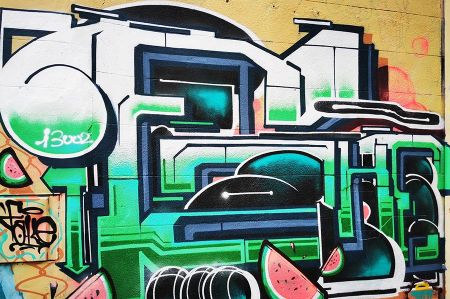Street Art – Colourful Quartier du Panier
- Written by Portal Editor
The pure curiosity of discovery led us to explore the narrow side streets at the Vieuw Port, some of which lead quite steeply and narrowly up into the old town of Marseille.
And once again we shouldn't be disappointed, because it started quite colorfully, almost like in Metelkova, the hip district of Ljubljana.
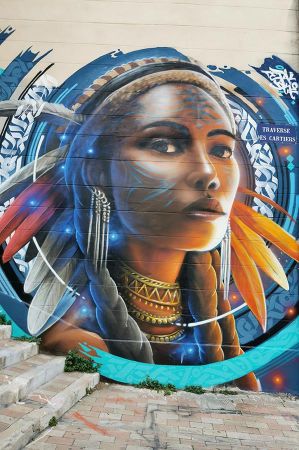 But it became much more interesting, even more colorful and artistic, because on the narrow streets of the Panier Hill the path leads past the shop windows of small shops with a lot of individual cabaret and small things that are hand-made with craftsmanship and offered for sale , the narrow streets often surprisingly ended in large squares with nice bars and restaurants, which reveal the district as an open-air urban art gallery - one work of art followed another.
But it became much more interesting, even more colorful and artistic, because on the narrow streets of the Panier Hill the path leads past the shop windows of small shops with a lot of individual cabaret and small things that are hand-made with craftsmanship and offered for sale , the narrow streets often surprisingly ended in large squares with nice bars and restaurants, which reveal the district as an open-air urban art gallery - one work of art followed another.
And green everywhere – whether in old oil cans or clay pots. Idyllic and relaxing at the same time.
Even if you usually dismiss street art and graffiti as graffiti, real masterpieces of cabaret can be found here in Marseille.
We were particularly impressed by the portraits of women in traditional clothing and corresponding hairstyles. But as so often: purely a matter of taste!
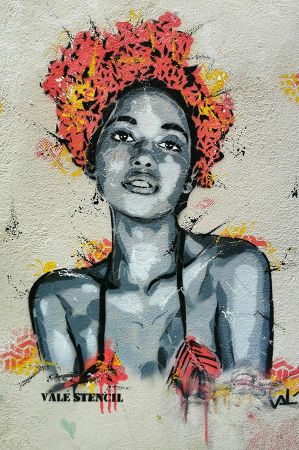 Along with the Cours Julien and La Plaine, the Quartier du Panier is considered a street art hotspot in Marseille with good reason: murals (huge pictures on house facades), pochoirs (stencil graffiti), mosaic pictures, papier-mâché totems and other works adorn these districts. Graffiti artist Arnaud takes us on one of his colorful city tours through Marseille.
Along with the Cours Julien and La Plaine, the Quartier du Panier is considered a street art hotspot in Marseille with good reason: murals (huge pictures on house facades), pochoirs (stencil graffiti), mosaic pictures, papier-mâché totems and other works adorn these districts. Graffiti artist Arnaud takes us on one of his colorful city tours through Marseille.
Style writing/graffiti writing or writing for short is now the most widespread form of graffiti and is therefore perceived most strongly by the general public.
Due to this fact, there is usually no differentiation from other forms of non-writing-related graffiti in the general population.
Short excursion into the categories of street art
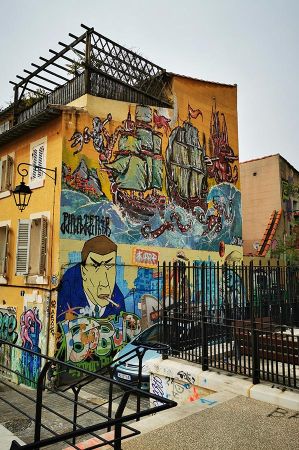 When writing, the writing (letters and numbers) forms the basic element of the image composition and the actors (writers) place artistic demands on themselves.
When writing, the writing (letters and numbers) forms the basic element of the image composition and the actors (writers) place artistic demands on themselves.
Modern scratching, in which tags are scratched into plastic surfaces or the windows of public transport such as trains, trams and buses using stones, shards of glass, sandpaper or knives, came about in the mid-1990s as a response from the writing scene to increasingly timely cleaning of painted and sprayed graffiti. In many public transport vehicles, especially in Berlin, the windows were sometimes scratched to the point of being opaque.
The concept of property damage is the order of the day here.
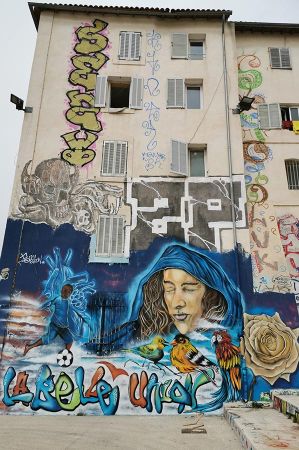 The basic shapes of the letters of the Pixação are predominantly borrowed from Fraktur fonts, runes and the typography of the logos of heavy metal bands. These are abstracted to create individual lettering.
The basic shapes of the letters of the Pixação are predominantly borrowed from Fraktur fonts, runes and the typography of the logos of heavy metal bands. These are abstracted to create individual lettering.
The individual characters in the lettering, which are often as tall as a man and can also contain figurative representations, usually have a uniform height and are clearly demarcated from one another. The letters are usually quite tall and narrow.
The term street art includes non-writing-related artistic graffiti, stencils, sticker art, posters and installations in public spaces. Many actors in the adbusting scene are also street artists. In street art, pictorial motifs usually play a larger role than writing.
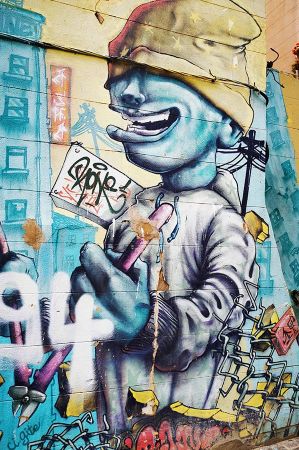 A stencil or pochoir is a template that must be made beforehand and through which the color is then sprayed. Politicians, political symbols, ideologically represented people or socially critical motifs are often sprayed according to their original use.
A stencil or pochoir is a template that must be made beforehand and through which the color is then sprayed. Politicians, political symbols, ideologically represented people or socially critical motifs are often sprayed according to their original use.
Viral graffiti refers to graffiti or stencils that contain “DNA” so that anyone can reproduce them as often as they like or spread them virally. For example, a link or QR code is placed within the viral graffiti, which leads to a website where the original graffito can be downloaded as a template.
street art marseille 10Political graffiti is usually rather artistically undemanding and only serves to anonymously represent various views, mostly directed against the authorities. Topics include: Ideology, religion, anti-Semitism, racism and discrimination against minorities such as homosexuals.
They are also an expression of anger against, for example, the police and political power structures (especially in authoritarian and totalitarian systems) or generally represent slogans or even just symbols.
Guided tours of the old town Quartier du Panier
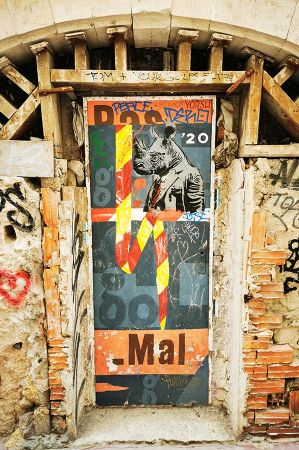 There were always comments and questions from the many visitors, so it was decided to offer guided tours with appropriate explanations through the old town, and, believe it or not, with increasing success.
There were always comments and questions from the many visitors, so it was decided to offer guided tours with appropriate explanations through the old town, and, believe it or not, with increasing success.
A few years ago, the thirty-year-old graffiti artist Arnaud decided to take curious and interested people through the streets of the historic center of Marseille:
"Street art naturally took root in Marseille in the 1980s with the emergence of hip-hop culture and the emergence of an art scene dominated by IAM and Fonky Family in the following decade," explains Arnaud, who uses the pseudonym " Asha” signed.
In the Rue Caisserie, where there are also some of Asha's works (for those looking for a tour without a tour of an organic restaurant), which are often inspired by plants, Asha explains the background to his art.
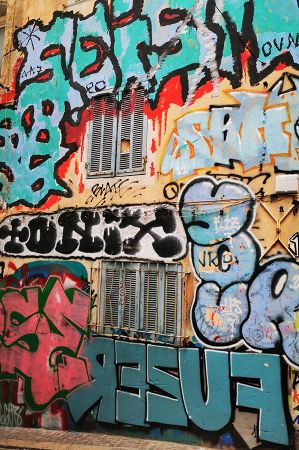 For example, playing with speed and distance when using the spray can to achieve different effects.
For example, playing with speed and distance when using the spray can to achieve different effects.
The work that goes beyond the wall of the house is by Nhobi, a Brazilian artist from Marseille, whose works can also be found in other corners of the Quartier Panier with rich colors and simple characters. In the restaurant, Arnaud presents works in the calligraffiti style, a sophisticated mix of oriental-inspired calligraphy and graffiti.
Further down the street, at the corner of Place de Lenche, Arnaud points to an Aztec dragon fixed in height: "That's the Quetzalcoatl by the graffiti artist Oré." We learn that it is a piece of wood that was cut with a jigsaw and painted.
Other techniques flourish on the surrounding walls: the stencil with the face of General De Gaulle by the Lille artist Mister P or a mesmerizing poster with the portrait of a woman in a swirl of colors by Manyoly, a painter responsible for street art in Marseille discovered himself.
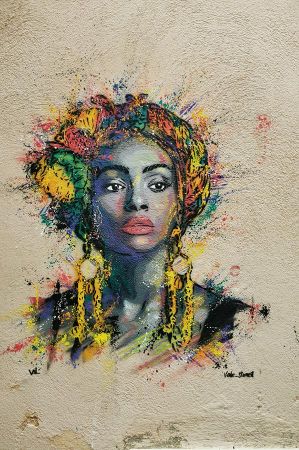 Arnaud continues his explanations: "We choose a wall because of its visibility. It becomes a 'Hall of Fame' when several graffiti artists put their mark on it."
Arnaud continues his explanations: "We choose a wall because of its visibility. It becomes a 'Hall of Fame' when several graffiti artists put their mark on it."
Here, near the Vieille Charité, a former hospice that we will discuss in more detail later, with monumental architecture, there are huge colorful frescoes by street artists such as Gamo, Easy and Difuz or Nhobi and Seek 313. Based on the work of In the latter we recognize the Old Port, Notre-Dame de la Garde as well as a cheeky seagull and a sardine fisherman who is about to jump out of his colorful boat. Marseille and its street art is special!
Please also read:
One afternoon in Sirince...vineyards to see!
The charming fishing town of Foça near Izmir
 Street Art Marseille - Quartier du Panier
Street Art Marseille - Quartier du Panier
Street Art Marseille - Quartier du Panier
Street Art Marseille - Quartier du Panier
 Street Art Marseille - Quartier du Panier
Street Art Marseille - Quartier du Panier
Street Art Marseille - Quartier du Panier
Street Art Marseille - Quartier du Panier
 Street Art Marseille - Quartier du Panier
Street Art Marseille - Quartier du Panier
Street Art Marseille - Quartier du Panier
Street Art Marseille - Quartier du Panier
 Street Art Marseille - Quartier du Panier
Street Art Marseille - Quartier du Panier
Street Art Marseille - Quartier du Panier
Street Art Marseille - Quartier du Panier
 Street Art Marseille - Quartier du Panier
Street Art Marseille - Quartier du Panier
Street Art Marseille - Quartier du Panier
Street Art Marseille - Quartier du Panier
 Street Art Marseille - Quartier du Panier
Street Art Marseille - Quartier du Panier
Street Art Marseille - Quartier du Panier
Street Art Marseille - Quartier du Panier
 Street Art Marseille - Quartier du Panier
Street Art Marseille - Quartier du Panier
Street Art Marseille - Quartier du Panier
Street Art Marseille - Quartier du Panier
 Street Art Marseille - Quartier du Panier
Street Art Marseille - Quartier du Panier
Street Art Marseille - Quartier du Panier
Street Art Marseille - Quartier du Panier
 Street Art Marseille - Quartier du Panier
Street Art Marseille - Quartier du Panier
Street Art Marseille - Quartier du Panier
Street Art Marseille - Quartier du Panier
 Street Art Marseille - Quartier du Panier
Street Art Marseille - Quartier du Panier
Street Art Marseille - Quartier du Panier
Street Art Marseille - Quartier du Panier
 Street Art Marseille - Quartier du Panier
Street Art Marseille - Quartier du Panier
Street Art Marseille - Quartier du Panier
Street Art Marseille - Quartier du Panier
 Street Art Marseille - Quartier du Panier
Street Art Marseille - Quartier du Panier
Street Art Marseille - Quartier du Panier
Street Art Marseille - Quartier du Panier
https://www.alaturka.info/en/france/marseilles/6610-street-art-colorful-quartier-du-panier#sigProId8eb2ea003f
